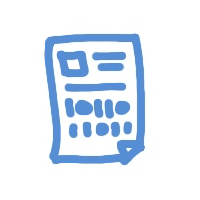1/28/20 20:28
Digital Tools for The Digital Age
We now live in the Digital Age, where more and more of how we work, learn, and play is done digitally. The problem is we are still steeped in an Industrial Age mindset. That is, we hold assumptions and accept limitations that are simply no longer true.

Digital vs. Industrial Age Thinking
The Industrial Age was based on the fact that atoms are hard to move around. Mass has inertia. Value was associated with "stuff". Big, heavy, or fixed things were expensive. Things with no mass were regarded as fluff.
The digital world is based on bits. There is no mass, no space, and no time. The mantra of the Digital Age might well be: Anything, Anywhere, Anytime.
What is the equivalent of mass and inertia in the Digital Age? Change and complexity. Keeping up with constant change and managing compounding complexity are our main challenges today.
The Industrial Age prized efficiency - doing more with less. The Digital Age rewards adaptability - doing things better in different ways. Maximizing new capabilities, and combining them in the right ways to solve the problems at hand.
The epitome of the Industrial Age was the assembly line: specific parts in a specific order, doing the same thing every day. This model of thinking permeated way beyond the factory floor.
The model for the Digital Age is the network: everything and everyone connected to everything else. Infinite combinations allowing for the best possibilities to arise.
A key characteristic of digital bits is that they are perfect: You can make exact copies of them, and those copies can be distributed near-instantaneously, at essentially zero cost.
This allows for infinite scale: anything you can do, you can do 10, 100, a million times greater.
But you can only scale if you work digitally. Give a lecture in person to 100 people, and you will need to give the same lecture again for the next 100 people. However, if you record and publish your lecture online, any number of people can watch it at no additional cost or effort on your part.
How do we plug into these digital powers?

Digital Tools are Our Interface to the Digital World
We may live in the Digital Age, but we are the same physical creatures as before. We rely on tools to adapt to the digital world. Our tools form our interface to the world. They focus our attention and they amplify our impact.
Here's the good news: You probably already have the tools, or you can easily get them.
The main limit is in what we think we can (or cannot) do with the tools we have.
In the Industrial Age, consumption was easy (accessible to the many) but production was hard (controlled by a few).
But in the Digital Age, production is as accessible as consumption.
For example: If you are reading this, you have a computer (or phone or iPad). That same device used to consume can also produce and publish to the world. Not just articles, but books, photos, videos, and even apps.
We shape our tools, and they shape us.
Good tools make us better by facilitating better ways of thinking: fluid and multi-modal thinking that matches the nature of the Digital Age.
They enhance better ways of doing: letting us create the way we prefer, maximizing our ability to express ourselves.
And they make sharing what we do easy: using the best digital media to distribute your work to the most people, or to the right people, amplifying our impact.
Good tools matter.

How We Think About Digital Tools
At Qrayon, we see ourselves as toolmakers. Our focus is building the best tools for the Digital Age.
Industrial Age tools were designed for specialists: you needed weeks of training to operate a movie camera or audio mixer.
Early digital tools followed this pattern: they assumed a high level of technical skill in their users (think Photoshop or After Effects).
Modern digital tools are designed for all of us. They use familiar interfaces and representations for things so you don’t need special training to immediately be productive with them. But (this is the important bit) they are not limited by those representations.
Good tools should be the best of both worlds: as easy to use as the things are are familiar with, and as powerful as the “pro” tools used by specialists.
Digital tools should be a bridge from our Industrial Age mindsets into the Digital Age.
For example, Cardflow represents bits of information as index cards - something we are all instantly familiar with. But you can do things you could never do with physical cards: Connecting them, arranging them with a single gesture, or linking them to web pages.
You quickly realize that these aren't just index cards, but a flexible hyperlinked information system - something that didn't quite exist in the Industrial Age model of the world.
Noteflow looks and works like digital paper. You can write, draw, or type on it. You can even pull in physical notes as digital ink using Inkport. But once in Noteflow, you can easily move and resize things to any level - turning the sheet of paper into a mental canvas for thinking.
Vittle works like a digital whiteboard, but one you can record a video of, and you can also pull in pictures, slides or documents. Use it as you would use a whiteboard in a classroom or meeting, and you instantly create a video you can post online, or share with your colleagues.
When you can do that, you soon realize that you can do it from anywhere. There is less need for everyone to be in the same room at the same time. You become vastly more productive, and so do the people you work with.

The World Turns On
It's still morning in the Digital Age, but things are beginning to accelerate.
Technology changes the terrain of the possible. It makes things that used to be hard trivially easy, and what once was priceless now too cheap to count. It can turn kings into paupers, and empower individuals like never before.
The important question is: what are you going to do with it?